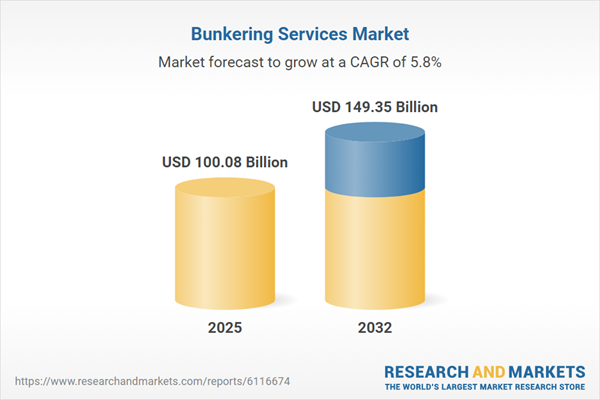Speak directly to the analyst to clarify any post sales queries you may have.
The bunkering services market is rapidly transforming as senior maritime executives confront complex environmental regulations, technological innovation, and evolving global fuel demands. Understanding this sector’s shifts is crucial for those overseeing international shipping and maritime fuel supply strategies.
Market Snapshot: Bunkering Services Market Size and Trajectory
The Bunkering Services Market grew from USD 94.78 billion in 2024 to USD 100.08 billion in 2025. It is expected to continue growing at a CAGR of 5.84%, reaching USD 149.35 billion by 2032. This growth reflects both increased global shipping activity and a profound shift toward sustainable refueling solutions, digital management systems, and diversified supply networks, as the bunkering landscape responds to rising regulatory and operational pressures.
Scope & Segmentation
- Fuel Type: Heavy Fuel Oil, Liquefied Natural Gas, Low-Sulfur Fuel Oil, Marine Gas Oil, Very Low Sulfur Fuel Oil
- Service Type: Bunkering Operations, Fuel Supply
- Vessel Type: Commercial Vessels (Bulk Carriers, Container Ships, Cruise Ships, General Cargo Ships, Tankers), Fishing Vessels, Leisure & Private Yachts, Naval & Defense Vessels, Offshore Support Vessels
- Service Mode: Barge-To-Ship, Ship-To-Ship, Shore-To-Ship, Truck-To-Ship
- Vessel Size: Large Vessels, Medium Vessels, Small Vessels
- Distribution Channel: Direct Sales, Third-Party Brokers
- End User: Commercial Shipping, Cruise Lines, Defense Vessels, Fishing Vessels, Offshore Energy, Private Yachts
- Regions: Americas (United States, Canada, Mexico, Brazil, Argentina, Chile, Colombia, Peru), Europe (UK, Germany, France, Russia, Italy, Spain, Netherlands, Sweden, Poland, Switzerland), Middle East (UAE, Saudi Arabia, Qatar, Turkey, Israel), Africa (South Africa, Nigeria, Egypt, Kenya), Asia-Pacific (China, India, Japan, Australia, South Korea, Indonesia, Thailand, Malaysia, Singapore, Taiwan)
- Key Companies Analyzed: Glencore plc, TotalEnergies SE, Atlaslab, BP Marine Limited, Chevron Corporation, Chimbusco Pan Nation Petro-Chemical Co.,Ltd, Dan-Bunkering Ltd., Exxon Mobil Corporation, Fratelli Cosulich S.p.A., GAC Group, Gunvor SA, Hong Lam Marine Pte Ltd, Integr8, KPI OceanConnect A/S, Minerva Bunkering Group, Monjasa, Neste, Peninsula Petroleum Limited, PJSC LUKOIL, Shell Plc, Sinochem Energy Co., Ltd., TFG Marine Pte. Ltd., Vitol, World Kinect Corporation
Key Takeaways for Senior Decision-Makers
- New environmental standards continue to reshape procurement strategies and drive the adoption of alternative marine fuels and cleaner bunkering options.
- Digital technologies, including real-time fuel monitoring and predictive maintenance, enable more precise risk management and operational agility.
- Service modes and distribution channels are evolving to support both high-capacity refueling at major hubs and niche, rapid-response delivery in emerging ports.
- Regional nuances influence infrastructure investment, with Asia-Pacific expanding LNG facilities and Europe focusing on emission compliance and storage technologies.
- Industry partnerships between fuel suppliers and digital firms are increasing transparency and supporting compliance with traceability requirements.
- Providers leverage modular and flexible delivery systems to serve a diverse vessel portfolio while maintaining cost controls and quality standards for all end users.
Tariff Impact: Navigating 2025 U.S. Policy Shifts
The 2025 U.S. tariffs on maritime fuel imports have introduced new dimensions to global cost structures and supply chain navigation. Shipping operators are revising sourcing options and exploring alternative suppliers or storage locations outside tariff zones. Collaborative contracts and scenario planning now play a greater role in managing pricing uncertainty and ensuring continued operational efficiency.
Methodology & Data Sources
This analysis integrates structured expert interviews, extensive field surveys at key port hubs, and secondary research that includes industry publications and policy documents. A triangulated approach secures accurate validation, with scenario-based models offering further insight into future market dynamics and sector resilience.
Why This Report Matters
- Enables senior leaders to align supply chain, procurement, and compliance strategies with industry transformation.
- Facilitates informed investment decisions by clarifying segmentation, regional risks, and emerging sustainability trends.
- Supports proactive technology adoption and partnership formation to ensure regulatory readiness and steady market positioning.
Conclusion
Senior industry stakeholders should leverage these insights to optimize fuel procurement, advance sustainability, and maintain supply chain agility. The evolving bunkering services market favors a forward-looking approach that balances technology, compliance, and collaboration.
Table of Contents
3. Executive Summary
4. Market Overview
7. Cumulative Impact of Artificial Intelligence 2025
Companies Mentioned
The companies profiled in this Bunkering Services market report include:- Glencore plc
- TotalEnergies SE
- Atlaslab
- BP Marine Limited
- Chevron Corporation
- Chimbusco Pan Nation Petro-Chemical Co.,Ltd
- Dan-Bunkering Ltd.
- Exxon Mobil Corporation
- Fratelli Cosulich S.p.A.
- GAC Group
- Gunvor SA
- Hong Lam Marine Pte Ltd
- Integr8
- KPI OceanConnect A/S
- Minerva Bunkering Group
- Monjasa
- Neste
- Peninsula Petroleum Limited
- PJSC LUKOIL
- Shell Plc
- Sinochem Energy Co., Ltd.
- TFG Marine Pte. Ltd.
- Vitol
- World Kinect Corporation
Table Information
| Report Attribute | Details |
|---|---|
| No. of Pages | 185 |
| Published | October 2025 |
| Forecast Period | 2025 - 2032 |
| Estimated Market Value ( USD | $ 100.08 Billion |
| Forecasted Market Value ( USD | $ 149.35 Billion |
| Compound Annual Growth Rate | 5.8% |
| Regions Covered | Global |
| No. of Companies Mentioned | 25 |









